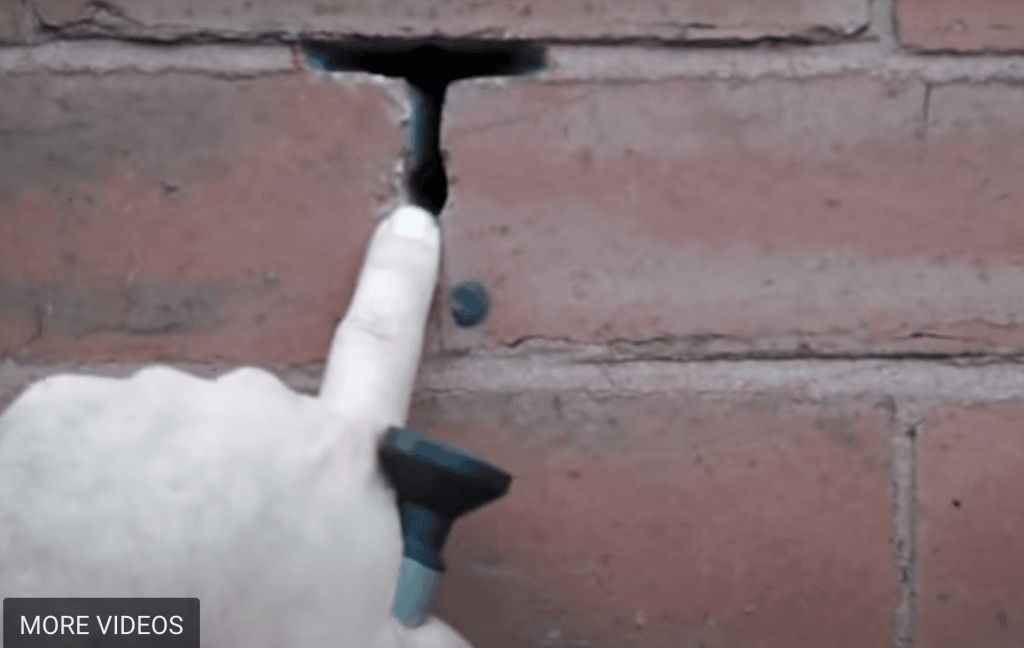A Wall Tie report on a house with an insulated cavity
Preparation of a pre purchase wall tie report, for evidence of wall tie corrosion, will usually involve looking at the wall ties in the cavity using a boroscope. However, this can be difficult, where the cavity has been filled with cavity wall insulation.
The common way of getting around this issue is by removing a brick. This is time consuming and will inevitably disfigure the house. This is not so bad when the wall ties are found in poor condition, as work will be recommended anyway. However, what if the ties are in good condition? Removal of a brick cannot be hidden and there will either be a broken brick to replace, or a freshly pointed single brick, which looks odd and untidy. Of course vendors hate this too.
In the video from a wall tie survey in Wakefield, West Yorkshire, we demonstrate one of the methods we use to complete the inspection. We were there to prepare a wall tie report for a house with an insulated cavity with minimal disruption, avoiding brick removal.
Read on for more details about what needs to be done when preparing a wall tie report. Or call our friendly and helpful team on Leeds 265 2752 York 566577 or Sheffield 224 5121 or email us via our contact page
The wall tie report methodology
Our surveyor uses a fine tuned metal detector to precisely locate a sample for inspection. He scans many ties until one is found directly above a perp’ joint. These are the vertical joints between the horizontal beds.
An inspection hole is drilled directly below the wall tie position and compressed air is used to clear the insulation from that point. Our surveyor makes a visual check with the boroscope and then clears the perp’ so that there is no mortar in the section between the underside of the wall tie and the inspection hole. As can be seen this allows the wall tie to be inspected in the cavity, along its length to the external tip.
The visual journey from good wall tie to bad wall tie in one go
The view includes the section of the wall tie in the cavity (now the insulation is cleared). In the video you can see that the metal is a dull silver colour. This is the galvanised (zinc), coating which protects the metal under it from rust. The surveyor then moves the boroscope out of the wall and the view travels along the underside of the wall tie. The next zone, reveals a rougher looking surface. Look carefully; you can see that initially there is a very dark matt grey boarder, before the metal is stained bright white and becomes rather ‘lumpy’.
The dark matt grey is the failing zinc coating. The white colour is zinc oxide. In effect this is the zinc rusting away. Note that the view is not yet within the perp. The white zone starts a few millimetres from the internal face of the external leaf. The ‘lumpiness’ is due to the expansive corrosion of the mild steel under the zinc. This happens because the zinc oxide allows water and oxygen through to the underlying mild steel, which begins to rust. That rusting action pushed the zinc away from the metal. The zinc oxide is lifted and peels.
As the boroscope passes into the perp’ joint, the part of the wall tie, which was originally embedded in mortar, in the outer leaf is revealed. This shows naked red rust. This is ferric oxide from the rusting mild steel the tie is made of. The removal of the bed-joint material has pulled the weak and corroded zinc oxide away with it. You now see the true condition of the tie underneath.
Travel further out and the boroscope shows a very red rusty surface with some loss of section (thickness). What will our wall tie report class this level at? Answer: this is advanced wall tie corrosion in a terminal phase.
We put this in perspective below, but of you’d rather get on and book your own wall tie survey or for more information call Leeds 265 2752 York 566577 or Sheffield 224 5121 or email us via our contact page
Wall Tie report – The significance of terminal phase wall tie corrosion.
Lots of houses have ties in them with some corrosion, this may be slight and ‘early stage’ which would only need monitoring. Rather like slightly high blood pressure in humans.
A wall tie corrosion survey is not only about looking at the type, number and condition of the wall ties. It must also include a detailed external inspection, of the building envelope to check for cracks, bulges and any movement associated with wall tie corrosion. Any cracking must be included in the wall tie report
In this case the walls display the typical horizontal cracks in the bed-joints, which suggest advanced wall tie corrosion. Accessing these by ladder, our surveyor scans them with his metal detector. The metal detector reveals that the cracks correspond to the position of the old wall ties. There are no horizontal cracks in bed joists which lack ties. Coincidence? No; in effect the house is now displaying the visual symptoms of wall tie corrosion. Think; rather than mere high blood pressure, this patient now gets dizzy walking up stairs and medical attention is needed.
Horizontal expansion cracking is a serious weakening of the external leaf brickwork. Walls are designed to work as a homogenous panel. Once cracks develop, the wall is in effect split into horizontal panels only a few hundred millimetres tall. The cumulative effect of the growth in the outer leaf, can cause premature bulging of the wall and even catastrophic failure of the wall. This can happen even in cases where the remaining section of the ties is quite high. How? This happens because wall ties are only as strong as the weakest point. Failure does not have to happen in the way you would expect. The metal can break of course, but this is rare for fishtail type ties*.
Wall tie failure usually happens as negative wind loading, acting to pull a wall outward, causes a shear failure, between the tie and mortar it is embedded in. In effect the rusty and friable oute layers act as a kind of lubrication, allowing the wall to slide out and leave the wall ties behind. The tie is left firmly embedded, in the now exposed inner leaf, because of course that end of the tie is not corroded.
Conclusions for the wall tie report.
The conclusion in a case like this; the presence of horizontal cracks, combined with confirmed wall tie corrosion, must result is the scheduling of remedial wall tie replacement as soon as is practically possible.
Never ignore or put off wall tie corrosion work, if the walls display horizontal cracking. To do so risks partial collapse of the external brickwork during high winds. This happens every winter and is an increasing event.
If you are concerned at all about wall tie corrosion please call our experienced and helpful team. We’re here to help Leeds 265 2752 York 566577 or Sheffield 224 5121 or email us via our contact page
*Very long term corrosion of fishtail type cavity wall ties can result in the ties ‘snapping’ however this is not common. The reason is that in cases where wind loadings are high, structural failures we’ve see have always tended to happen, despite the wall ties having some remaining section. In less exposed areas the wind loading does not appear to cause this mode of failure. However, it the corrosion is left for a very long time then the near complete loss of section, which inevitably happens, can result in failure with quite low wind loading, albeit much later.
Exceptions to the above include cases where the corrosion has been accelerated by aggressive mortars such as black-ask mortar from industrial waste. We have seen failure where the section of tie in the outer leaf has literally broke away; being almost non-existent.
In addition, great care should be taken in using horizontal cracking only, as an indicator of wall tie corrosion. There are cases where fishtail ties can be very badly corroded, to the point of failure and there may be no visible cracking. This is due to differences in the composition and thickness of the ties and bed-joint mortar.
Thin section wire ties rarely cause significant cracking. Failure mode in these cases is usually the wire simply rusting through and snapping off. There may be no signs of a structural problem right up to the point a wall collapses.
Any property constructed prior to 1983 may have a problem with wall tie corrosion. Most post-war houses, especially those constructed in the 1950-83 period, are at risk. These ties tend to be mild steel wire ties, with inadequate galvanised protection. These are the houses most at risk of ‘hidden’ advanced phase wall tie corrosion. Only a random wall tie survey, such as that required when properties change hands, or are re-mortgaged will uncover such corrosion.
To see how our wall tie expertise is used by local authorities, larger construction companies, housing associations and commercial building developers too – visit our commercial wall tie section.


